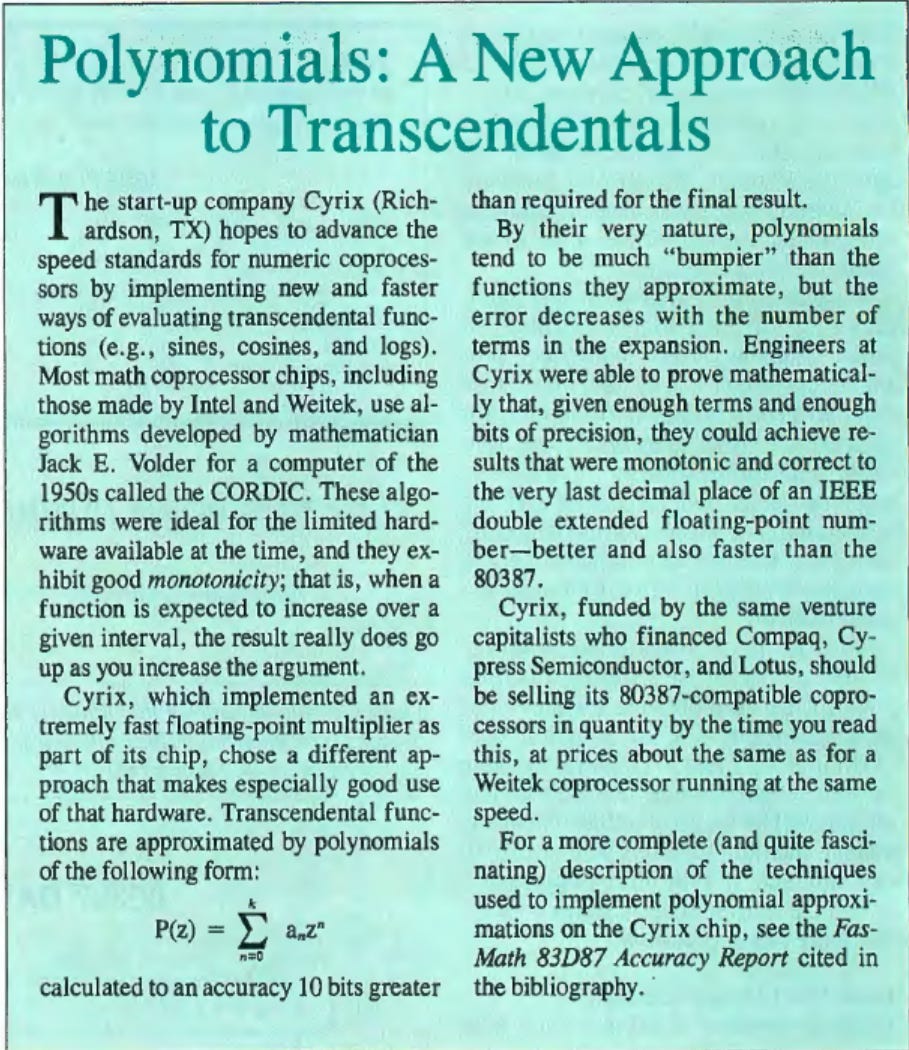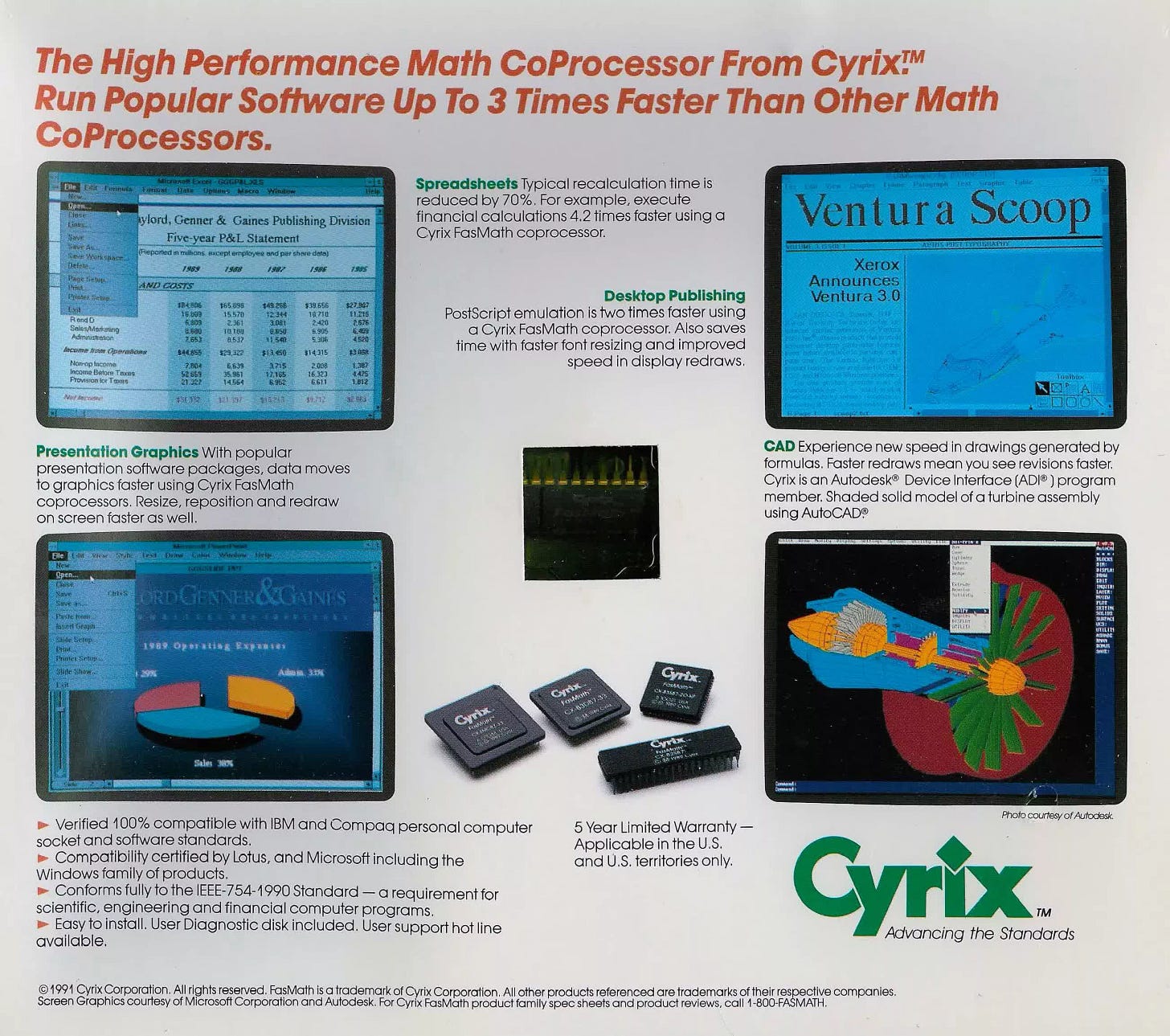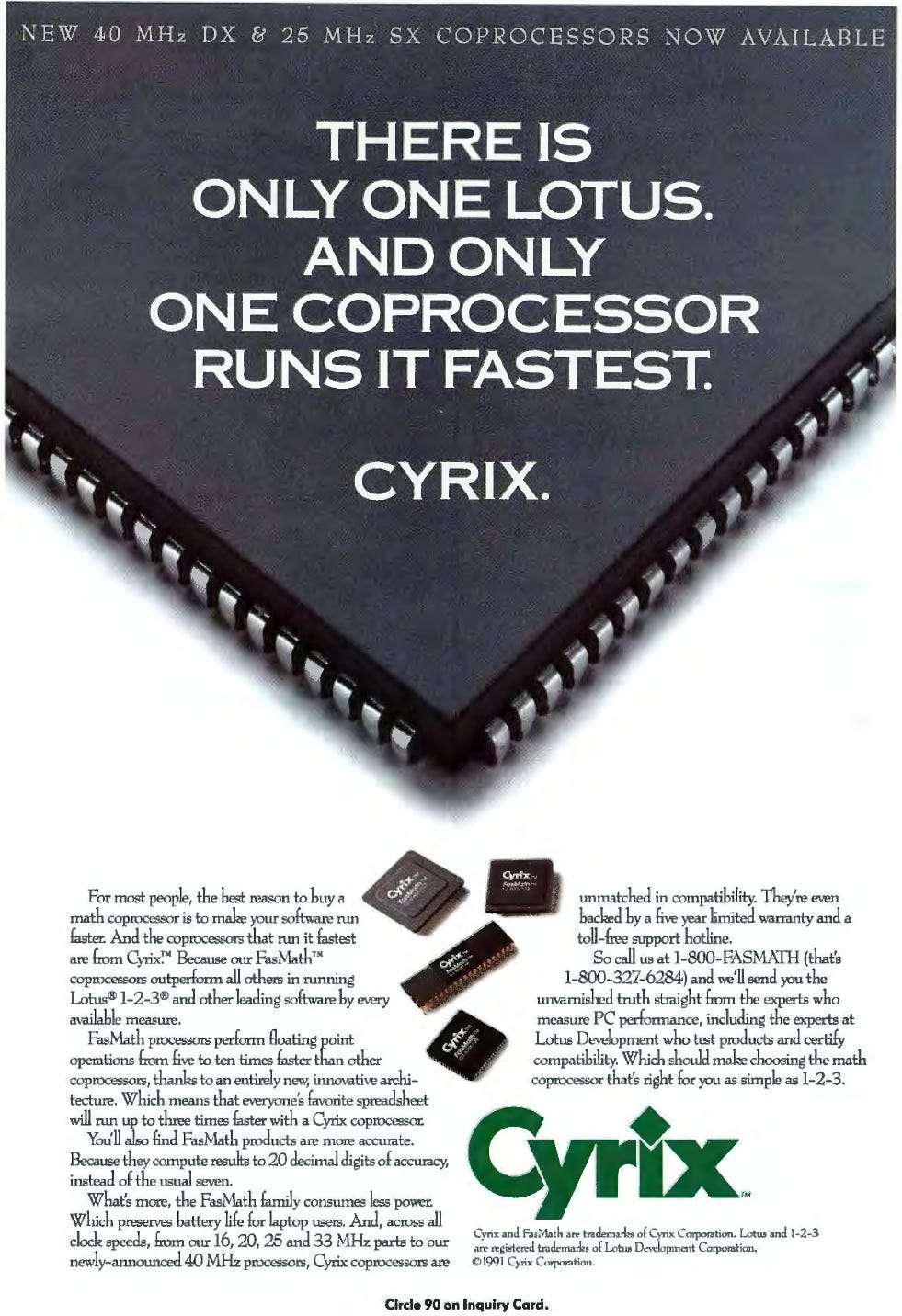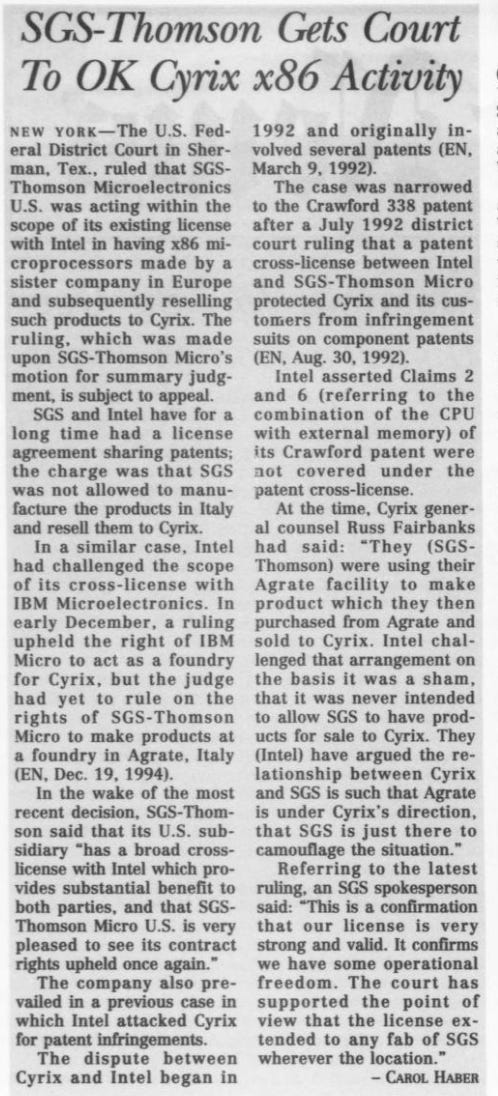A Brief History of Cyrix
Litigation: it's the American way
Tom Brightman and Jerry Rogers were working for Texas Instruments in the second half of the 1980s. The two were apparently not content to work for others forever, and they had a few product ideas that they felt could build a successful company. Among those ideas were an 80287 and an 80387 compatible floating point math coprocessors or FPUs. They started a company called APT Corporation in 1987 aimed at building these FPUs, and they hired Bill Briggs to help them. Their new company was a fabless semiconductor firm at a time when most other chip companies had their own fabs. The home of APT was, coincidentally, next to the offices of Sevin and Rosen in Dallas. Naturally, Sevin and Rosen invested. APT was now three people, $4 million, and another ten million shares divided among the investors and three person team.
The first few months of life saw APT grow to about twenty people total, and work on an 80387 compatible chip that would be ten times faster than the 80387 started almost immediately. The company’s engineers seriously just sat down, looked at the 80387’s datasheet, and they divided the clock counts by ten. This had a somewhat strange side effect in leaving the FPU idle quite often as it waited on the CPU. This helped with power and heat a bit. The very first working chip the company produced was named L7 after L. J. Sevin, and while the first version never made it out of the lab, it did function. It was around the time of the tape out of this design that Sevin and Rosen suggested a name change for the company. APT became Cyrix.
The second version of the L7, version 1.5, also didn’t make it. The third version, 1.7, became the Cyrix 83D87. This chip was intended for use alongside the 80386DX as a drop-in replacement for the 80387. It didn’t quite achieve the ten times improvement goal at which the company’d been aiming, but it got about half way there while using about one twentieth the power of the Intel 80387. The chip was manufactured on a 1.2 micron process at IBM and SGS-Thomson, and it was available at clocks of 20MHz, 25MHz, or 33MHz. A version of the chip was also made available for use with the 80386SX, and this was the 83S87. It made all of the same improvements but was available in 16MHz and 20MHz versions. Together, these two chips constituted the Cyrix FasMath brand upon release in November of 1989. Pricing started at $506. Shortly after the release of the 386 coprocessors, Cyrix reworked the 83D87 design to create the 82S87 for the Intel 80286.
Intel wasn’t exactly enthusiastic about Cyrix’s products. They filed their first lawsuit in May of 1991. I say first as Intel followed the initial one with several more at multiple courts in Texas. Ultimately, the courts found Cyrix not guilty of any wrong doing. As Cyrix didn’t use any of Intel’s designs and the fabs that manufactured their chips had licenses to produce hardware implementing the ISA, Cyrix could continue their work. Further, Intel ended up settling a retaliatory antitrust claim made by Cyrix out of court for $12 million and licenses for several Intel patents. Importantly, at no point did Cyrix copy Intel’s hardware or microcode despite gaining these licenses.
With the L7 variants doing well-enough in the market, Cyrix began working on their next product. The goal was to have a single chip that would be capable of handling either the DX or the SX variants of the Intel 80386. Importantly, Cyrix didn’t want to lose speed, accuracy, or power efficiency. They made some path improvements to allow the new chip to be even faster than its predecessor, but all of these requirements combined to create a large die. This chip was called COMBO, and while Cyrix met all of their various goals, it was more expensive to manufacture. This wasn’t a great time to be making a more expensive chip as Weitek and Intel were lowering their prices. This led to another new core that they called CRX. This was a smaller core with reduced costs both at retail and in production. While being cheaper and slightly less speedy, it was still faster than anything from Intel or Weitek.
By 1992, the processor landscape was quickly changing. In the realm of Cyrix FasMath FPUs, pricing had fallen to just $89 for the low end and $299 on the high end. Part of the reason for this price decrease was that these FPUs were truly only helpful for 80386 and lower CPUs as the Intel 80486 and later CPUs integrated an FPU and cache on the CPU die. To remain in the fight, Cyrix had to create its own 486 compatible CPU and just such a product was introduced on the 15th of April in 1992. These were the Cx486SLC, Cx486DLC, Cx486SX, and Cx486DX the first 486 compatible chips released from a company that wasn’t Intel itself. The Cx486SLC was binary compatible with the 486SX but it trimmed the cache to just 1K as opposed to the 8K cache on the Intel product. This chip also lacked an integrated FPU, and instead worked with any 80387 compatible FPU. This was a quite capable processor, but it didn’t quite match the performance of Intel’s 486 chips. The performance difference was a byproduct of the Cx486SLC being designed to upgrade what were previously 386 designs. A company could purchase Cyrix’s chips and drop them into designs intended for a 386 and have new and updated products for their customers with minimal work. The Cx486SLC shipped in two different versions and both were surface mount components to OEMs. The first was 25MHz operating at 5V and the other was 20MHz operating at 3V. Both of these featured a 16bit external data bus and 24bit address bus (limiting the system 16MB of RAM). These were incredibly power efficient little chips consuming just 0.5mW to 2W. The DLC parts did much the same for previously 386DX systems. The Cx486SX and DX didn’t launch until later that year despite being announced at the same time, and these were more or less standard 486s, but were half the price of the Intel parts while delivering about ninety percent of the performance. Versions of Cyrix’s 486 chips were available in 3.3V, 4V, and 5V. This made Cyrix’s DX2 and DX4 chips amazing upgrade options for those with older 486 motherboards. Naturally, Intel didn’t like this development. They sued. They lost again.
The following year, Cyrix took their Cx486SLC and DLC parts and released the Cyrix 486SRX2 and 486DRX2. These were clock doubled versions of the SLC/DLC products with circuits added to maintain cache coherency, but these were marketed exclusively to retail consumers as upgrades for their old 386 machines. Prices for these ranged from $299 to $399. By late 1993, slightly updated 486SLC and DLC chips were finding their way into consumers’ hands with subnotebooks. These were notable for being low power and not requiring any active cooling.
In 1994, Cyrix and IBM signed a manufacturing deal in which IBM would manufacture Cyrix’s x86 chips and IBM would then have the ability to sell those chips under its own name without royalty. The majority of Cyrix chips from that point forward were manufactured by IBM, but SGS-Thomson made some as well.
On the 5th of June in 1995, Cyrix announced its 5x86 processor family. The 5x86 was designed to compete directly with Intel’s Pentium while using less power. Just as prior Cyrix chips had enabled the 386 to 486 transition cheaply, the 5x86 was meant to bring Pentium-like performance and features to systems designed for the 486. The 5x86 also differed from the Pentium in that it lacked branch-prediction. This is a feature that had been promoted by Cyrix, but was disabled in the released product due to instability. Most of the 5x86 chips produced were 3.6V and clocked at 80MHz, 100MHz, or 120MHz. While a 133MHz part existed, it was rare. Most of those were allocated to OEMs making upgrade modules like the Evergreen 586.
On the 23rd of October in 1995, Cyrix announced the 6x86. This was a Socket 7 chip and it wasn’t a compromise chip like 5x86. This had the full suite of features one would expect from a Pentium, and it was speedy. According to Cyrix, it was faster at the same clock than a given Pentium chip, so the 6x86 PR166+ ran at 133MHz but was comparable to 166MHz Intel chip. Upon launch, this claim was generally true, but this was a time when everything in the industry was advancing quickly. The software ecosystem began taking advantage of the FPU in the Pentium and Cyrix’s 6x86 suddenly wasn’t quite as shiny. The FPU in the Cyrix chip lacked pipelining, and this resulted in some performance problems in software optimized for the Pentium’s FPU specifically. The most notable example of this was Quake.
First announced on the 20th of February in 1997, it was in June of 1997 that Cyrix’s MediaGX was in the hands of consumers via the Compaq Presario 2120 ushering in the era of sub-$1000 IBM compatible PCs. Tom Brightman had started a skunk works at a Cyrix location in Longmont, Colorado a few years earlier to produce a system-on-a-chip that combined a 5x86 core with graphics and audio. The MediaGX was the result of that skunk works, and it was built on a 0.4 micron process, had 16K cache, a bus speed of 33MHz, and was clocked at 120MHz, 133MHz, or 150MHz. The 150Mhz chip cost $99, the 133Mhz chip cost $88, and the 120MHz chip cost just $60. Of course, these were bulk prices available to OEMs and not to the end consumer.
On the 14th of May in 1997, Cyrix sued Intel for violating patents. The claim was that the Intel Pentium Pro and Pentium II made use of Cyrix technologies, but the veracity of this claim was never tested in a court of law. Intel promptly settled out of court, and this resulted in a cross licensing arrangement between the two companies. The problem was that Intel had sued Cyrix a total of seventeen times by this point, and the cost of these legal actions coupled with bad press due to FPU performance took their toll. With declining revenues, mounting losses, and no breakthrough product ready to hit the market Cyrix sold to National Semiconductor for around $550 million.
Cyrix did manage to overcome their floating point shortcomings with the 6x86MX and MII chips. These improved compatibility, increased cache size, added the MMX instructions, lowered voltages, and increased clock speeds. Yet, these chips also created a new problem. The MII had an 83MHz bus which was unusual and caused stability issues with some PCI devices. The last few models the MII fixed nearly all of the CPU line’s problems, but it was a bit too late. Intel and AMD were moving quickly and consumers’ had moved with them.
National Semiconductor also wasn’t all too interested in competing in the high end. They were far more interested in the MediaGX. Under National Semiconductor, Cyrix produced the MediaGXi. This was a version of the MediaGX produced on a 0.35 micron process, lowering heat output and power consumption. The GXi was also available at higher clock speeds of 166MHz and 180MHz. A proper Pentium II compatible version was also produced, the MediaGXm. This version was built on 0.35 micron process, could be clocked as high as 266MHz, had 16K total cache, integrated a PCI controller, 2D graphics accelerator, MPEG-1 decode, Sound Blaster 16 compatible sound, and a 64bit SDRAM controller. The MediaGXm (rebranded as Geode GXm) got a die shrink to 0.25 micron allowing it to use as little as 1W which was released as the Geode GXLV. The GXLV was also die shrunk to 0.18 micron and released as the GX1. This version could reach clock speeds of 333MHz and consume as little as 0.8W. The GX1 was typically used with a Cirrus Logic CS5530 ADC.
On the 3rd of August in 1999, National Semiconductor sold Cyrix to VIA Technologies but without the Geode line. The Geode line was sold to AMD in August of 2003. The Geode products continued under AMD, but the Cyrix line was largely canceled under VIA. Two new processor cores had been made Cyrix III/Joshua and Jalapeno. Neither of these ever came to market. Shortly after buying Cyrix, VIA had purchased Centaur Technology and it was Centaur cores that created VIA C3, C7, and Nano when those products came to market. For Geode, the name is what really continued. Cyrix at National Semiconductor had produced the Geode GX2. This was an SoC produced on a 0.15 micron process with MMX and 3DNow!, 16K instruction cache, 16K data cache, 64bit memory controller capable of supporting PC133 SDRAM and DDR266, and a 33MHz PCI bus. The GX2 could be clocked at upto to 400MHz. This became the AMD Geode GX, but it wasn’t long before the x86 cores were replaced with what was essentially an AMD K7. All work on updating the Geode line was ceased around 2009. Interestingly, the patents and licenses held by Cyrix transferred to NatSemi and then finally to VIA enabled the development of Zhaoxin CPUs today. The latest Zhaoxin x86 CPUs are comparable to first and second generation AMD Ryzen CPUs.
Cyrix was incredibly innovative, and they pushed competition in the x86 CPU market quite well. Unlike Intel and AMD, Cyrix didn’t switch to using RISC internally with CPU microcode handling instruction translation. Instead, Cyrix maintained a traditional CISC design. Despite this, they were able to remain competitive long past what many would have assumed possible. The company also created one of the earliest, complete, SoCs. Today, it is somewhat normal to have a large die that includes graphics, audio, CPU, storage controllers, memory controllers, and bus controllers, but this wasn’t really the case in the 1990s for any consumer product. The lasting impact of Cyrix in the market is felt in most acutely in that latter regard, but it may yet be that the patent portfolio and licenses previously held by Cyrix turn out to be far more important. Zhaoxin was founded in 2013 as a joint venture between VIA Technologies and the government of Shanghai, allowing the Chinese technology sector to continue development regardless of the global political climate. Whether or not one views this as a good thing, this is certainly a very large impact on our modern world that originated in the intense desktop competition of 1990s. This time period comes up again and again on ARF, as it is likely the most transformational time period in the history of our world. The race to the bottom in pricing forced innovation on all fronts. Home-owned microcomputers were falling in price year over year while the power of those machines was quickly increasing. This combination led common devices to become what essentially amounts to microcomputers. It became cheaper to make something utilize a CPU rather than some bespoke circuit. This then enabled further innovation in technologies in all sectors. Cyrix was at the front of the that wave of change, and the world is a better place today thanks to their fine work.
I have readers from many of the companies whose history I cover, and many of you were present for time periods I cover. A few of you are mentioned by name in my articles. All corrections to the record are welcome; feel free to leave a comment.





